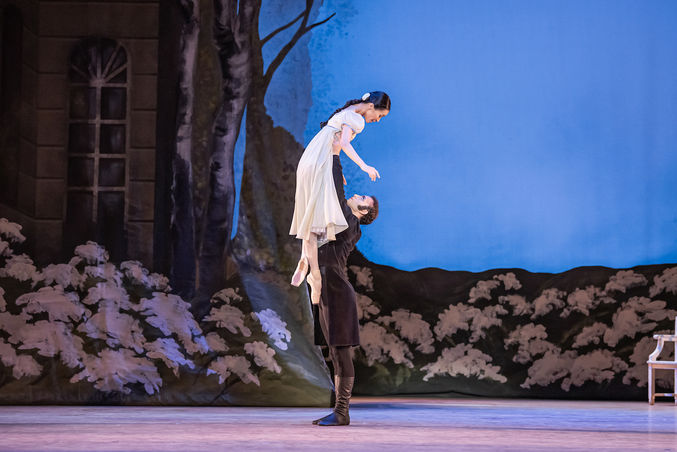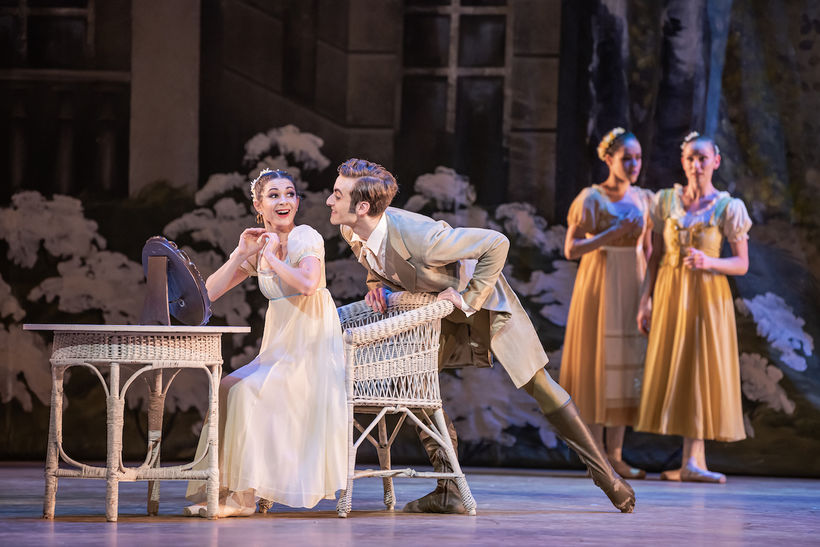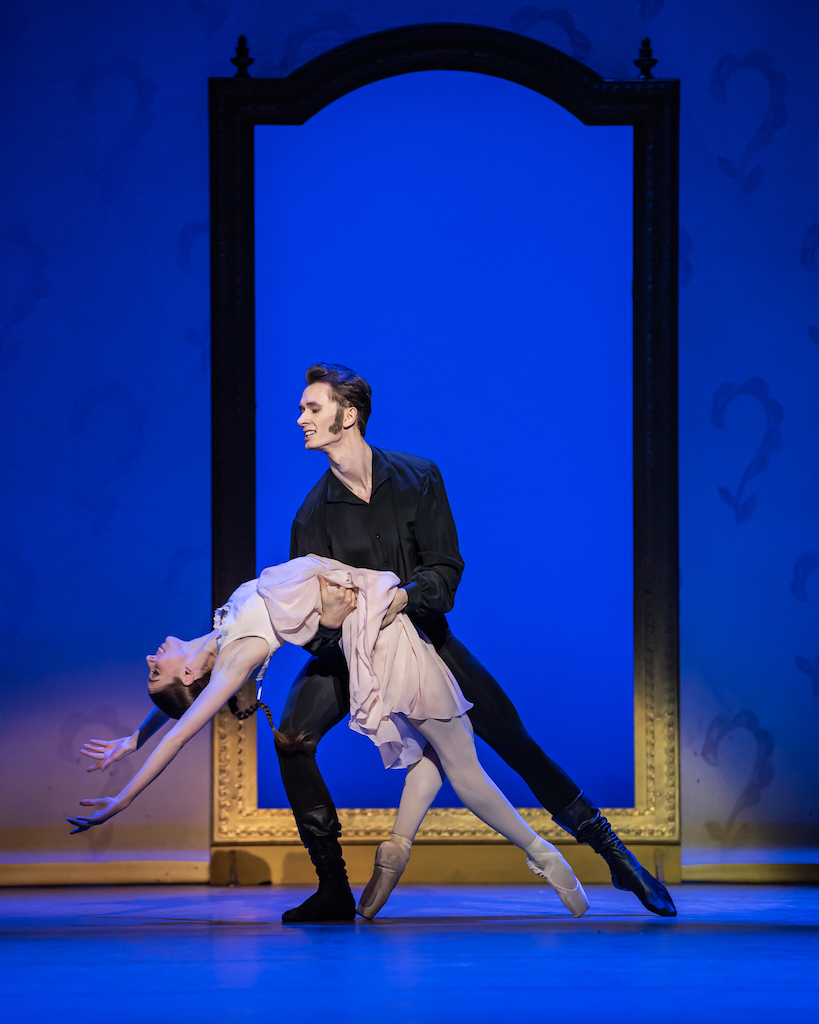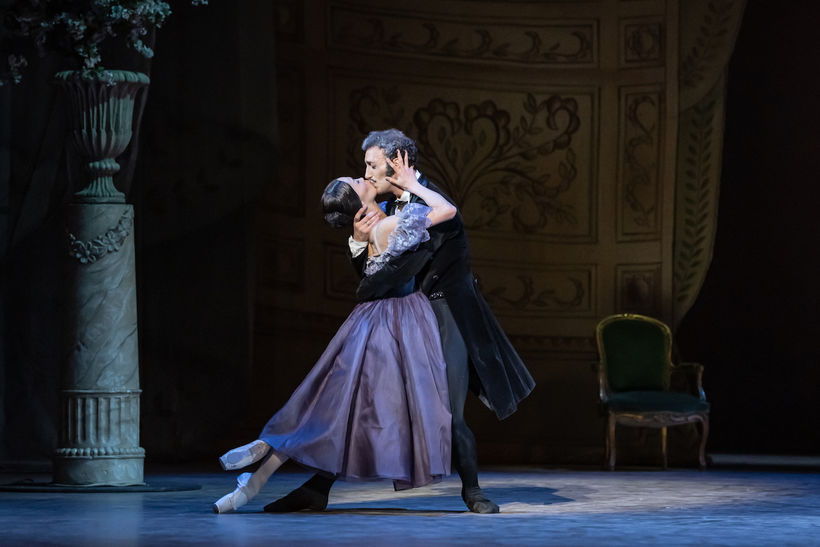Onegin returns to Czech National Ballet
Within the span of twenty years (that is one generation), the Prague’s National Theatre ballet-goers have had the unique opportunity to experience four stagings of a ballet based on Alexander Sergeyevich Pushkin’s famous verse-novel Eugene Onegin. It premiered in the National Theatre in 1999 under the directorship of Vlastimil Harapes, on the occasion of the 200th anniversary of the poet’s birth. Onegin by the Russian team Vasily Medvedev (choreography, direction and music selection) and Valery Modestov (libretto), in cooperation with the Czech costume designer Josef Jelínek and Slovak set designer Milan Ferenčík, was staged in the Estates Theatre. Unfortunately, they had to use recorded music, as the collage of Tchaikovsky’s symphonies, arranged by Medvedev together with Petr Malásek, appeared to be too difficult to be played by a live orchestra. The main parts were danced by soloists, of whom many (for example Tereza Podařilová, Nikola Márová, Alexandr Katsapov, Jiří Jelínek) later impersonated the same characters of Puskin’s story in the choreographic version by the South African creator John Cranko, pushed through by the then artistic director Petr Zuska in 2005. In the meantime, Jiří Jelínek took on the role of Onegin in Stuttgart and danced it in the National Theatre as a guest (paired with the Stuttgart Ballet first soloist Sue Jin Kang) and he later performed it all over the world (Canada, Vienna, Hamburg, China, Japan and Australia). In 2011, under Petr Zuska’s directorship, Cranko’s Onegin returned to the Czech National Ballet’s repertoire.

Oněgin (Moho Ogimoto, Giovanni Rotolo). Foto: Serghei Gherciu.
Since 2007, Filip Barankiewicz (the current artistic director of the Czech National Ballet Prague) has appeared repeatedly as Onegin in guest performances. He has brought the title back to the repertoire and participated in the staging along with the choreologist Jane Bourne. He thus replaced Ivan Cavallari, who had collaborated with J. Bourne on the previous production and helped Tereza Podařilová and Jiří Kodym win Thalia Awards for the title roles. What did the return of Cranko’s Onegin to the National Theatre look like?
The first premiere (with the numerologically interesting date 20 February 2020) opened in a very awkward manner, with the dancers fulfilling their tasks instead of radiating breath-taking energy and electrifying stage presence. Corps de ballet dances were not in perfect unison, especially the port de bras were incoherent, as if the dancers did not know which shape was the right one, and this imperfection recurred in the following acts. There were no épaulements, no tilting of the torso, no subtle bending of the head and the upper body, which hurt the dance and the drive. All steps were executed rather mechanically, with too much tension, but lacking dynamics and liveliness. The male Russian dance made the same impression, the dancers played it safe and acrobatic steps - which could have liven up the dance a little - were reduced to a bare minimum, The costumes for this character dance, designed by Elisabeth Dalton, looked strange – the white rubashka-style shirts were too long, brown tights (not the typical bell-shaped trousers) were paired with boots of the same colour. This attire looked almost ridiculous on the dancers. Failed costume design, deforming the silhouette of the traditional Russian male costume!
The performance came back to life in the 2nd and 3rd act. The central couple (Miho Ogimoto as Tatiana and Giovanni Rotolo as Onegin), in an attempt to heat up the cold atmosphere of the colourless first act, began to overplay it at the expense of providing detailed portrayals of their characters’ emotional twists. They are both experienced soloists of very high qualities, however, they did not make a complementary couple which resulted in a series of technical mishaps in the final duet. Filip Barankiewicz is not particularly good at casting dancers, as proved by last year’s premiere of Cranko’s Swan Lake. Of course, in theory, all soloists are able to perform as a couple and dance a duet together, but some of them are simply more compatible then others. Finding the right ‘chemistry’ of their personalities can take a performance to a higher level or artistry.

Throughout the first act, Miho Ogimoto‘s expression was too tragic and unconvincing, as it did not match the character of the young Tatiana. Her portrayal of a mature woman was much more interesting. What could enhance her performance was a more refined psychological structure of her character, better articulation of arms and involving the upper body into her acting. Giovani Rotolo‘s Onegin was charismatic, however, he overplayed his mysteriousness and his dark and ominous timbre, which was at odds with Puskin‘s depiction of Onegin. Struggling to help his partner in finding the desired expression correlation, he also seemed restrained by the gestures – they looked too staccato and lacked inner motivation. In the ball scene, while watching Tatiana dance with her husband Gremin (Adam Zvonař), Rotolo stiffened and remained motionless for an unnaturally long time, without any visible resonance in his body. It was probably his intention, but ‘stage time‘ flies much faster and what would take your breath away in a movie seems just flat on stage. It would certainly be interesting to watch the evolution of individual characters in the upcoming performances. Hopefully, the soloists will work in better harmony when not supervised by the creative team.
Irina Burduji (Olga) and Federico Ievoli (Lensky) gave high-quality performances, technically precise, their expressions were appropriate, but they can still work on some subtle nuances of their characters and bring more movement ‘cantilena’ into their dancing (which would definitely help the central couple, too)
It was obvious the four protagonists were not synchronized enough– Cranko‘s ballets require more emphasis on subtle gestures, gazes, and reactions. During the premiere night, we could only witness a rough structure of the ballet and of individual dance-drama parts, as the performance remained halfway through the process of blending all components into a dramatic whole. As if the staging lacked artistic spirit...The final impression from the premiere was disappointing for many, especially those who had seen the previous versions. One of the spectators, a bit disconcerted, summed it up in quite an apt way: “But now it‘s somehow different, isn‘t it?“
The second cast was, as far as mutual accord is concerned, better chosen. Alina Nanu, feeling strong after having received the Thalia Award for the previous season, created a convincing and refined portrayal of Tatiana, and although she is much more experienced than her partner Patrik Holeček, who danced Onegin, she managed to encourage their mutual harmony without being too dominant. Thus she supported Holeček who debuted in this challenging role for which (looking too young and boyish) he did not have the right visual disposition. But he was able to overcome everything (his stage make-up was much more natural than Rotolo’s) and his dancing was confident, focused, psychologically well-structured and free of any mannerisms. Holeček did not neglect a single detail of his role and became an equal partner for Nanu. Since last year, this young artists has made a huge progress and it is nice to see he has been given such an opportunity.

Alina Nanu drew a picture of an uncomplicated, sincere and naive girl who is growing up at a country estate, longing for a different life that she only knows from books. Onegin opens doors for her to the unknown world and to unexplored emotions and she trusts him with all her soul. Patrik Holeček endowed his Onegin with gentleness and lyricism and therefore he was more faithful to the literary character than Rotolo. He tried to act with all his body, even when attention was on other dancers, and his gestures were charged with meaning. For example, when he hands Tatiana back her letter and tears it into pieces right before her eyes (Cranko’s idea, as opposed to Puskin’s original scene), Holeček’s Onegin softens his act by placing his hand on Tatiana’s shoulder and putting as much empathy into this gesture as possible – in Rotolo’s version, the same gesture looked more like pushing Tatiana away, like a prolongation of his previous coarseness. Such moments of acting refinement, which renewed the harmony between the meaning of the gestures and the literary source, were much more frequent in the second cast, and it definitely contributed to the success of the second premiere.
We should not forget to mention the noteworthy performances of the second pair of protagonists – Olga (Olga Bogoliubskaja) and Lensky (Matěj Šust). Bogoliubskaja danced her Olga with technical confidence, but in my opinion she wore the same wide grin throughout the whole piece. Next time she could add more shades to her cheerfulness and coquetry since otherwise it seemed flat and uninteresting. But she stood the test of the most dramatic scene before the final duel, her partner Matěj Šust supporting her. After the last kiss, when Olga tries to convince Lensky that he is the one she really loves, he lets her slide down his arm and fall to the ground – it looks more like he is trying to shake her off rather than pushing her away (as we could see in the fist cast).
The four protagonists form a tangle of relationships and conflicts. Matěj Šust’s acting was natural and spontaneous, without mannerisms, and compatible with Patrik Holeček’s presence. Accordingly, they tried to show the initial friendly relation between Lensky and Onegin, although Cranko’s version provides little space for it. They both knew what they were dancing about. Lensky’s pre-duel solo finally becomes what it should be: a monologue full of doubts of a soul deeply wounded by the betrayal of the beloved woman and the best friend, but also full of determination to take revenge. Šust was able to express all this through his dancing – one movement growing into another, use of dynamics, cambrés in the upper spine, expressive arms and torso which did not disturb the neoclassical form of the choreography. On the contrary, his performance give the choreography a meaning because in fact, its structure consists of a few arabesques and many pirouettes, as for other steps it is surprisingly poor.

The two evenings with the revivals of Cranko‘s Onegin, created in the 1960‘s (a period of searching for the future of neoclassical narrative ballets) are over. Certainly, it will be interesting to watch the third cast. How will they handle their roles? Will the corps de ballet, so far a bit imprecise, do better? As our first ballet company is becoming an international troupe, hiring dancers with diverse dance and artistic backgrounds, it will be hard to do. There is a good reason why so many world ballet companies have their own ballet schools from where they recruit dancers with a certain style that fits the classical or neoclassical repertoire. The Prague Dance Conservatory fulfilled this role through the 1990’s, but the situation changed when Petr Zuska became the artistic director of the Czech National Ballet,. He preferred his personal choreographic style, choosing dancers to fit his vision, and other titles were included only to please more conservative audiences. Filip Barankiewicz, on the contrary, inclines towards neoclassic ballets (the Western style, though), but he has not developed any relations with our conservatories yet. And because the schools put emphasis on the Vaganova technique and the Russian school which our teachers have most experience with (and with which they have succeeded), it is questionable whether they will be able to communicate with the Czech National Ballet. At any rate, both sides should try, otherwise the situation will remain unchanged.
To conclude, I would like to pose a question: Dramaturgy-wise, is it not about time the National Theatre presented some narrative ballets of Cranko‘s successors? For instance the works by Kenneth MacMillan or John Neumeier which could be seen only as occasional guest performances a very long time ago, or Jiří Bubeníček’s narrative ballets which have been staged by top theatre houses, including Teatro dell´Opera di Roma. I do not want to downplay the quality of Cranko’s Onegin, nevertheless, the ballet art is evolving and we are still reviving of a forty-year-old title within a very short span of time. Fifteen years ago, Onegin was staged to introduce Cranko’s successful work and it made sense. But now? Is the link between the current artistic director and his former home company a good enough reason? And does the Czech National Ballet really need no dramaturge of its own, while the Opera company has three (apart from the artistic director) and the Drama house has four?
Written from the premieres held on 20 and 21 February 2020, at the National Theatre.
Onegin
Choreography: John Cranko
Music: Pyotr Ilyich Tchaikovsky
Musical arrangement and orchestration: Kurt-Heinz Stolze
Sets and costumes: Elisabeth Dalton
Lighting and visual design: Steen Bjarke
Music director and conductor: Václav Zahradník
Cast:
Onegin: Giovanni Rotolo / Patrik Holeček / Danilo Lo Monaco
Tatiana: Miho Ogimoto / Alina Nanu / Nikola Márová
Lensky: Federico Ievoli / Matěj Šust / Paul Irmatov
Olga: Irina Burduja / Olga Bogoliubskaja / Ayaka Fujii
Gremin: Adam Zvonař / Marek Svobodník / Fraser Roach
Premiere: 20 Feb 2020
Translated by Tereza Cigánková.







